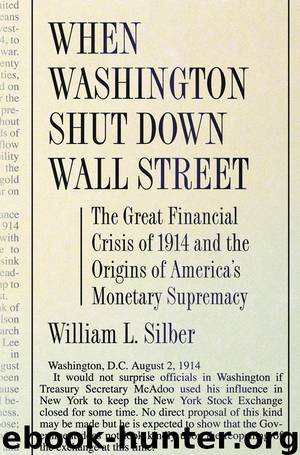When Washington Shut Down Wall Street by Silber William L

Author:Silber, William L.
Language: eng
Format: epub
Publisher: Princeton University Press
Published: 2014-08-20T16:00:00+00:00
THE NEW YORK STOCK EXCHANGE DEFENDS ITS TURF
The Committee of Five launched a frontal attack to deflect New Street’s challenge. On August 12, 1914, it authorized trading through the New York Stock Exchange’s Clearing House at prices “no less than the closing prices of Thursday, July 30, 1914.” The committee released the following guidelines: “Members of the Exchange desiring to buy securities for cash may send a list of same to the Committee on Clearing House giving amounts of securities wanted and the prices they are willing to pay. Members of the Exchange desiring to sell securities, but only in order to relieve the necessities of themselves or their customers may send a list of same giving the amounts of securities for sale. No prices less than closing prices of July 30, 1914, will be considered.”455 The committee left unspecified exactly what qualified as “only in order to relieve the necessities.”
The New York Stock Exchange Clearing House normally settled trades completed on the exchange’s trading floor. It employed hundreds of clerks to process the paper fluttering behind every transaction. As Wall Street’s back office, the Clearing House would receive the stock certificates from those who have sold on the exchange floor and then transfer those certificates to the buyers after accepting their payments. The trading suspension on July 31, 1914, left the Clearing House without any new business.
According to Noble, the trading system inaugurated at the Clearing House on August 12 required “a large clerical force [to] tabulate the orders received and bring purchasers and sellers together who were willing to trade in similar amounts and at similar prices. … To consummate a trade the Clearing House would notify both parties, leaving it to them to carry out the delivery and payment, and requiring them to inform the Clearing House when the transaction had been completed.” Somewhat ironically, the address given for communicating with the Clearing House was 55 New Street.
From the outset, the Clearing House trading facility maintained a low profile. The August 13 Wall Street Journal reports: “The Stock Exchange authorities refuse to divulge the amount of bids and offers for stocks in accordance with the rule adopted yesterday. Nor will they give out the stocks for which offers or bids were made, nor the prices. It is only known that advantage of the rule has been taken by a number of [brokerage] houses.”456
Did behind-the-scenes trading at the Clearing House smother New Street?
Noble conceded a seesaw battle between the trading forums: “A very considerable amount of business [at the Clearing house] began at once. Many people with ready money … appeared as purchasers and relieved the necessities of those who had been embarrassed by the war. A little later, when progress on the war took on a more discouraging aspect, this ‘Clearing House Market’ fell to the arbitrary minimum of the [July 30] closing prices, with a large excess of selling compared to buying orders, and the New Street market grew in proportion. During the darkest days of depression in prices … business in the Clearing House almost ceased.
Download
This site does not store any files on its server. We only index and link to content provided by other sites. Please contact the content providers to delete copyright contents if any and email us, we'll remove relevant links or contents immediately.
International Integration of the Brazilian Economy by Elias C. Grivoyannis(74798)
The Radium Girls by Kate Moore(11621)
Turbulence by E. J. Noyes(7700)
Nudge - Improving Decisions about Health, Wealth, and Happiness by Thaler Sunstein(7242)
The Black Swan by Nassim Nicholas Taleb(6764)
Rich Dad Poor Dad by Robert T. Kiyosaki(6175)
Pioneering Portfolio Management by David F. Swensen(6079)
Man-made Catastrophes and Risk Information Concealment by Dmitry Chernov & Didier Sornette(5647)
Zero to One by Peter Thiel(5488)
Secrecy World by Jake Bernstein(4388)
Millionaire: The Philanderer, Gambler, and Duelist Who Invented Modern Finance by Janet Gleeson(4094)
The Age of Surveillance Capitalism by Shoshana Zuboff(3985)
Skin in the Game by Nassim Nicholas Taleb(3965)
The Money Culture by Michael Lewis(3846)
Bullshit Jobs by David Graeber(3830)
Skin in the Game: Hidden Asymmetries in Daily Life by Nassim Nicholas Taleb(3723)
The Dhandho Investor by Mohnish Pabrai(3560)
The Wisdom of Finance by Mihir Desai(3523)
Blockchain Basics by Daniel Drescher(3329)
